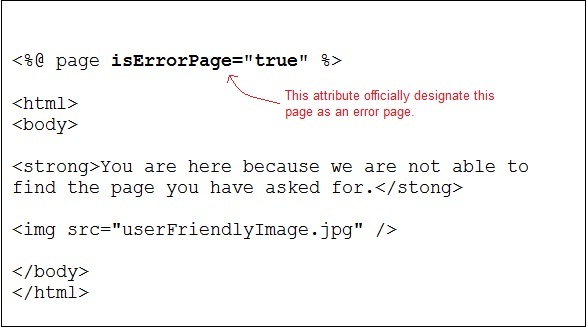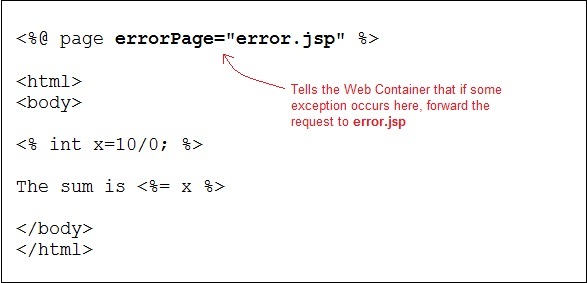Exception Handling in JSP
JSP Exception Handling
Exception Handling is a process of handling exceptional condition that might occur in your application. Exception Handling in JSP is much easier than Java Technology exception handling. Although JSP Technology also uses the same exception class objects.It is quite obvious that you dont want to show error stack trace to any random user surfing your website. You can't prevent all errors in your application but you can atleast give a user friendly error response page.
Ways to perform Exception Handling in JSP
JSP provide 3 different ways to perform exception handling:- Using isErrorPage and errorPage attribute of page directive.
- Using <error-page> tag in Deployment Descriptor.
- Using simple
try...catchblock.
Example of isErrorPage and errorPage attribute
isErrorPage attribute in page directive officially appoints a JSP page as an error page.error.jsp

errorPage attribute in a page directive informs the Web
Container that if an exception occurs in the current page, forward the
request to the specified error page.sum.jsp

Whenever an exception occurs in sum.jsp page the user is redirected to the error.jsp page, where either you can display a nice message, or you can also print the exception trace into a file/database in the background, to check later what caused the error.
Declaring error page in Deployment Descriptor
You can also declare error pages in the DD for the entire Web Apllication. Using<error-page> tag in the Deployment Descriptor. You can even configure different error pages for different exception types, or HTTP error code type(503, 500 etc).Declaring an error page for all type of exception
<error-page>
<exception-type>java.lang.Throwable</exception-type>
<location>/error.jsp</location>
</error-page>
<error-page>
<exception-type>java.lang.ArithmeticException</exception-type>
<location>/error.jsp</location>
</error-page>
<error-page>
<error-code>404</error-code>
<location>/error.jsp</location>
</error-page>
Using the try...catch block
Usingtry...catch block is just like how it is used in Core Java.<html>
<head>
<title>Try...Catch Example</title>
</head>
<body>
<%
try{
int i = 100;
i = i / 0;
out.println("The answer is " + i);
}
catch (Exception e){
out.println("An exception occurred: " + e.getMessage());
}
%>
</body>
</html>
Comments
Post a Comment